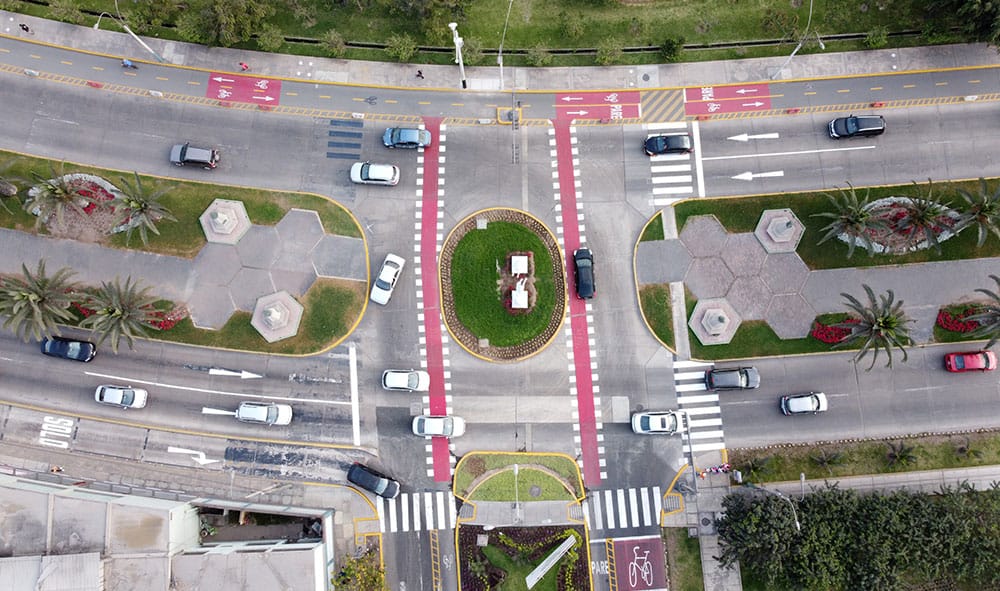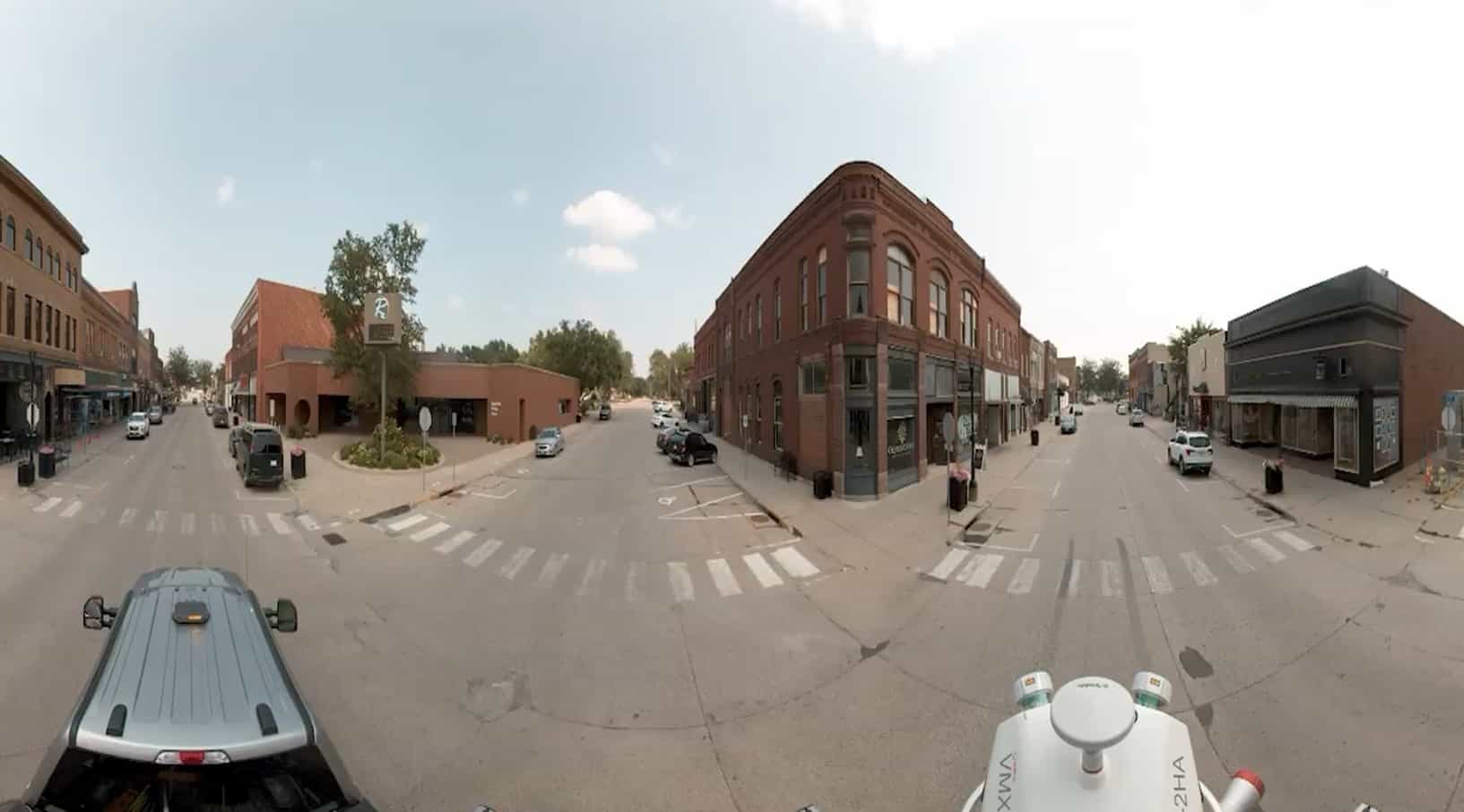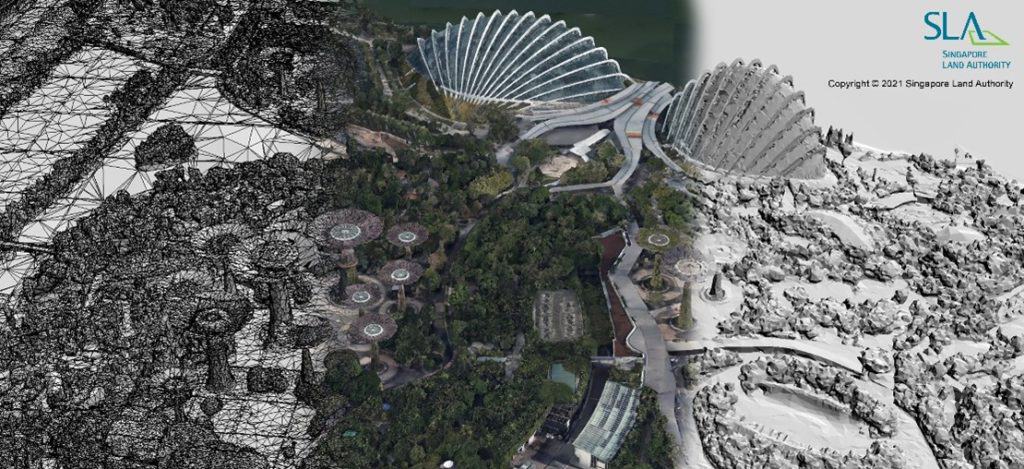We hear a lot about Complete Streets these days, but what does it mean and why is it important?
Basically, a Complete Street is safe, and feels safe, for everyone using the street.
Also known as Living Streets, Home Streets, or Woonerf outside of the U.S., a Complete Street is a street designed and operated to enable safe use and support mobility with all users in mind to make the transportation network safer and more efficient.
Our Car-Centered History
Transportation planning and roadway design have traditionally focused on the needs of drivers rather than those of all users of the street. After World War II, many communities were designed to facilitate easy and fast access to destinations via automobile. Over time, this approach contributed to the development of an environment where other modes of transportation including walking, bicycling, or transit did not see the same level of investment.
Since the 1970s, advocacy groups have championed the idea of “routine accommodation” in which the needs of cyclists and pedestrians would be considered during all roadway projects. Some of the first states to enact a Complete Streets-like policy in the United States were Oregon in 1971 and Florida in 1984. Both required that new or rebuilt roads accommodate bicycles and pedestrians and called on state and local governments to fund pedestrian and bicycle facilities in the public right-of-way.
Dutch, Danish, and German cities have incorporated living streets design concepts and policies and have seen improvements in overall street safety and for the more vulnerable modes of transport such as walking and cycling. The focus on living streets in countries like the Netherlands may be attributed to the more car restrictive policies they have had in place since the 1970s. The woonerf in Netherlands and Belgium, home zone in the UK, and Spielstraße in Germany require motorists to drive at walking speeds and yield to pedestrians, cyclists, and playing children who have the same rights in road use.
In 2003, bicycle advocates suggested replacing the technical phrase “routine accommodation” with a more powerful and inclusive term: Complete Streets. Representatives from American Bikes and the League of American Bicyclists subsequently formed the Complete Streets Task Force. In 2005, the Task Force Steering Committee formed the National Complete Streets Coalition, a program of Smart Growth America, which continues to advocate for the adoption of Complete Streets policies at all levels of government.
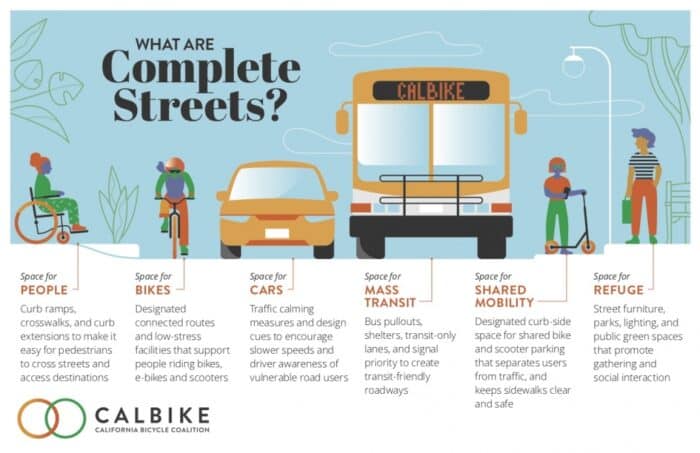 Image courtesy of California Bicycle Coalition
Image courtesy of California Bicycle CoalitionWhat Do Complete Streets Look Like?
The context and needs of users are different in rural, suburban, and urban communities, and streets will look different as a result, even when using a Complete Streets approach. Complete Streets can address a wide range of elements, such as sidewalks, bicycle lanes, bus lanes, crossing opportunities, median islands, roundabouts, accessible pedestrian signals, curb extensions, streetscapes, and landscape treatments. This approach can reduce motor vehicle-related crashes, and pedestrian and bicyclist risks. It promotes walking and bicycling by providing safer places to achieve physical activity and can increase business traffic in local communities.
A complete streets policy ensures that transportation planners and engineers consistently plan, design, operate, and maintain the entire roadway and roadway networks with all users in mind – including bicyclists, public transportation vehicles and riders, and pedestrians of all ages and abilities to maximize transportation choices.
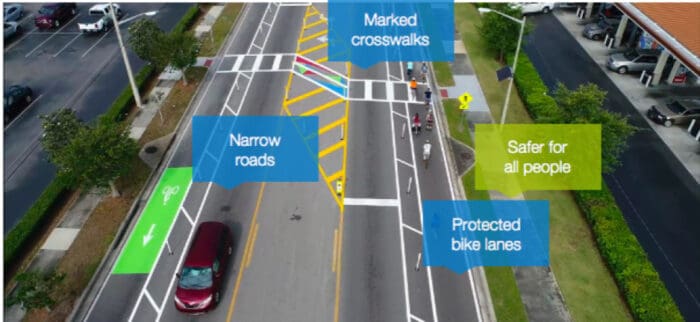 Addressing a wide range of elements, a Complete Streets approach can include marked sidewalks and bus lanes, protected bike lanes, and accessible pedestrian signals. Courtesy of Smart Growth America
Addressing a wide range of elements, a Complete Streets approach can include marked sidewalks and bus lanes, protected bike lanes, and accessible pedestrian signals. Courtesy of Smart Growth AmericaSome examples include:
- Mini-roundabouts, bike lanes, and curb extensions for ADA sidewalk ramps
- Widening the roadway to accommodate five-foot bicycle lanes in each direction
- Repurposing the existing outside lanes to accommodate bicycle lanes in each direction
- Improving existing roadway lighting
- Upgrading signage and curb ramps to current ADA standards.
- Milling and resurfacing the roadway
How Tangible Are the Benefits?
The Federal Highway Administration (FHWA) has identified a set of Proven Safety Countermeasures (PSCs) that support agencies when designing, accommodating, and operating streets that enable safe use and support mobility for all road users and provided the following statistics:
- Increasing lighting at intersections has been found to reduce nighttime injury crashes involving pedestrians by as much as 42 percent.
- Center line rumble strips can reduce fatal head-on crashes on two-lane rural roads by 44 to 64 percent.
- Adding a bicycle lane on certain roads can reduce the total number of crashes on them by as much as 49 percent.
- Changing a two-way intersection with stop signs to a roundabout can reduce fatal crashes by 82 percent.
Complete Streets Standards and Policies
Complete Streets policies can help states, metro areas, counties, cities, and towns transform how they make decisions about their streets. But a strong policy is just the first step in a much longer process to shape practices for street design.
 The Complete Streets approach is applicable to rural and urban environments, benefiting communities by addressing the needs of all road users.
The Complete Streets approach is applicable to rural and urban environments, benefiting communities by addressing the needs of all road users.The Infrastructure Investment and Jobs Act (IIJA), also known as the Bipartisan Infrastructure Law (BIL), Section 11206, defines Complete Streets standards or policies as those that “ensure the safe and adequate accommodation of all users of the transportation system, including pedestrians, bicyclists, public transportation users, children, older individuals, individuals with disabilities, motorists, and freight vehicles.” This section of the BIL requires that States and MPOs use 2.5 percent of their planning and research funds for Complete Streets activities that will increase safe and accessible transportation options.
According to the National Complete Streets Coalition, in the last 20 years, hundreds of jurisdictions across the United States have adopted Complete Streets policies directing their transportation agencies to routinely plan, design, build, and operate safe street networks for everyone, including two-thirds of the States, and many of those jurisdictions have gone on to create Complete Streets design models which transform their project-development processes to prioritize safety.
How Can Technology Help Advance Complete Streets?
Digital technologies are helping to drive innovation for initiatives such as Complete Streets. Over the last few years, there has been a major shift from 2D plans to digital delivery and 3D design which has helped engineers communicate information about the project scope to stakeholders and the community. Before this technology, engineering consulting firms would schedule public hearings or town hall meetings to show a set of 2D drawings that typically only an engineer could understand. Reality modeling and 3D technologies allow community members to see details about the project in a format they can comprehend and provide their feedback. This enables a better project in the long run as the community can be engaged ahead of time and changes can be made earlier in the process before the design is finalized. Because 3D reality models can be easily understood, they can accelerate the decision-making process and improve project team collaboration from design through construction. Digital delivery is helping to make the goals of Complete Streets viable and more successful.
Complete Streets in Action
Bentley users have been implementing Complete Streets in projects of varying sizes and geographies, whether they are called Complete Streets or another term. Hear firsthand from Foth and JMC2 about how they have incorporated Complete Streets features into recent projects. Register for our Roads & Bridges Webinar The benefits of moving to a Complete Streets design model.

